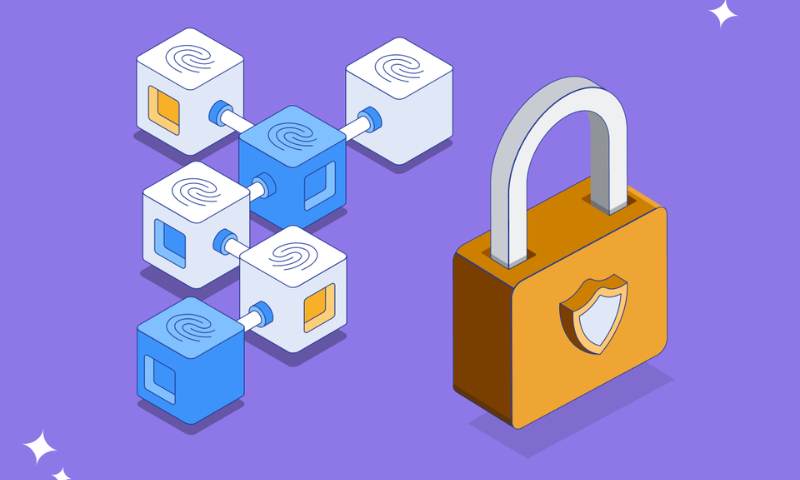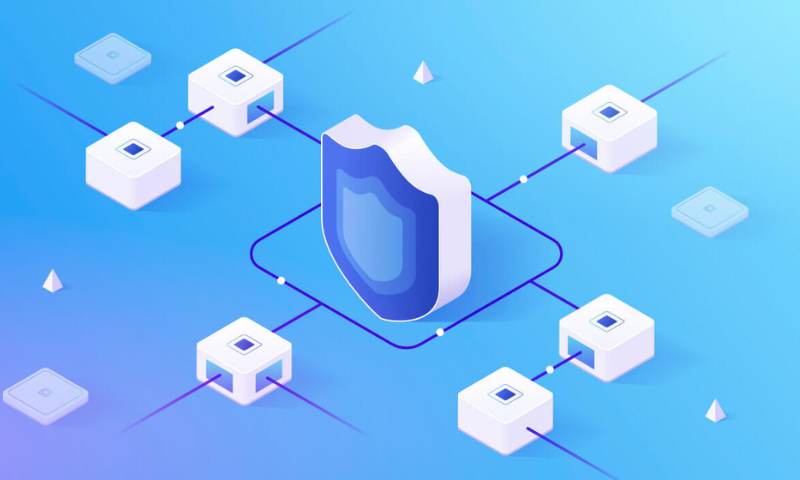Is blockchain secure? It’s a hot question, and I’ve got answers. Imagine a digital Fort Knox—seems unbreakable, right? But even Fort Knox could raise eyebrows. You’ve heard the hype. Blockchain’s the big tech buzz, known for keeping data snug as a bug. Yet, can anything be truly watertight in a world where cyber threats lurk around every byte? I dive headfirst into this digital safe, scouring every nook and cranny, to bring you the unvarnished truth about blockchain’s security chops. Buckle up; this isn’t just another tech talk. I’m here to peel back the layers of blockchain armor, from its cryptographic backbone to the myth-busting realities. Ready for a truth bomb? Let’s get cracking!
Understanding Blockchain Security Fundamentals
The Role of Cryptographic Hashing in Blockchain
Let’s talk about secret codes. In blockchain, they’re hash codes. These codes hide your data so well, bad guys can’t find it. How? By mixing it up! Like a smoothie, where fruits become impossible to separate. This “smoothie-making” is called cryptographic hashing. Each piece of data gets its own unique hash code. If anything changes, the hash code changes too and everyone knows. It’s like a secret that everyone guards.
Now, some may ask: “Is cryptographic hashing in blockchain super safe?” Yes, it is. No one can guess your hash code. It’s like your fingerprint – unique and private. People can see it, but can’t fake it. This keeps your blockchain security features strong. It’s much safer than just a password by itself. Remember, in the mix of security, hashes are king.
How Decentralization Enhances Security
Imagine a soccer team. If one player goes out, the game still goes on. Blockchain works like this. Many people hold the same data. It’s called decentralization. Bad guys can’t just hit one spot – they have to beat the whole team. That’s tough!
Some folks wonder, “Why is decentralization and security tied together?” Because spreading out control means no one bad apple spoils the bunch. If someone tries to cheat or mess up the data, the others stop them. It’s like a neighborhood watch. Everyone looks out for each other, keeping the area safe.
In short, more eyes on the data means fewer chances for sneaky moves. Peer-to-peer network protection makes sure we all play fair. And fair play equals safety in blockchain town.
Assessing Blockchain Vulnerabilities and Protections
The Realities of Smart Contract Security
Smart contract security is a must these days. A smart contract is code on the blockchain. It runs when set conditions are met. Think of it like a vending machine. You pick a snack, pay money, and get your treat. Easy, right? Now, smart contracts should be foolproof. Yet, crafty hackers find ways to break in. We work hard to keep these contracts safe. Sure, they can simplify business. But we need to keep them locked tight from bad players.
Why so much focus on smart contracts? They hold value, like money or property. If they have a flaw, a hacker can steal this value. So, we test them again and again. We check the code like a detective looks for clues. Only then can we trust them.
Risks and Prevention of Blockchain Hacking Attempts
Hackers love to find weak spots in anything, including blockchains. But, the blockchain is not easy to break. It has layers of security. We call these layers “blockchain security features”. They include fancy math called cryptographic hashing and consensus mechanisms. These make sure each block in the chain follows strict rules.
Hacking blockchain possibilities do exist. There are “blockchain attack vectors”. This means hackers try to find a way to trick the system. They might aim to change transaction details. Or they want to steal digital coins. Not cool, right?
Now, we have ways to stop these hackers. We use peer-to-peer network protection. This spreads data across many computers. So, if one is attacked, the rest still hold the correct data. Public vs private blockchain security differ. Public blockchains let anyone join. Private ones only let a few in. This can make private blockchains easier to guard.
Blockchain protocol flaws get fixed as we find them. We work to make every blockchain transaction secure. Some blockchains use proof of work. Others use proof of stake. These are ways to agree on who adds the new block to the chain. Both have ways to stop fraud but in different styles.
Let’s not forget, we have steps to ensure the blockchain encryption strength. Encryption is like a secret code. It hides the info so only those who should see it, can. This stops others from messing with the data.
In blockchain, we have to stay one step ahead of hackers. But don’t worry. Folks like me are on it. We love this game of cat and mouse. We stay up-to-date and always ready. We are defending against blockchain fraud. For you. For everyone. With us on guard, your blockchain experience stays safe and sound.
The Mechanics of Blockchain Safety Mechanisms
Consensus Protocols: Proof of Work vs. Proof of Stake
Let’s talk about keeping blockchain safe. It’s like a digital Fort Knox. Two big ways to do this are Proof of Work (PoW) and Proof of Stake (PoS). They’re both about making sure everyone agrees on the blockchain ledger. But they do this in different ways.
PoW makes folks solve hard puzzles to add a new block to the chain. It takes a lot of computer power, so it’s hard to mess with. PoS is different; it picks a person to add the next block based on how many coins they have. It uses less power and is faster.
Now, PoW is great because it’s tough to attack. To change things, a bad guy would need to control more than half the network’s power. That’s a lot. But this power need means it costs more money and can be slow.
On the other hand, PoS is lighter on power and money. But since it’s based on coin ownership, someone with lots of coins has more say. Both methods have their pros and cons, but they work well to keep blockchain secure.
Examining the Implications of Immutability
Blockchain is like a book that can’t be erased. Once something is written, it stays put. This is called immutability. It’s good because it means records are permanent. People trust it more since you can’t just change things you don’t like.
But this also means if there’s a mistake or a glitch in a contract, it’s stuck. This can be a risk, especially with smart contracts that run on their own. If these contracts have bugs, they can be big problems. Also, what if new rules are needed? Changing them isn’t easy when everything is set in stone.
Overall, blockchains keep our digital world safer. It’s not perfect, and bad guys are always looking for weak spots. But with strong ways to agree on data and permanent records, it’s a big step forward for online safety. We just have to keep checking for those risks and protect against them.
Navigating Advanced Security Concerns in Blockchain
Combating Potential Quantum Computing Threats
The idea of quantum computers might sound like sci-fi. But it’s a real worry for blockchain. These super machines can break codes fast. Let’s dig in.
Do they threaten blockchain? Yes, with enough power, they could crack current crypto tech. Blockchain uses complex math to protect your stuff. Quantum computers can solve these math problems much faster. That means they could trick blockchain systems.
What’s being done? Experts work hard to make quantum-proof blockchains. They do this by creating new algorithms that even quantum computers can’t crack. This means that even as computers get smarter, your blockchain stays safe.
Enforcing Security Through Blockchain Audits and Standards
Blockchains get checked to keep them safe. Think of it like a health check-up but for blockchain. Blockchain audits look for any flaws that could let hackers in. This is important because once a blockchain goes live, it’s tough to change. Checking it first bodes well for its future.
Standards are rules that help make blockchain secure. They ensure everyone follows the best methods for safety. These rules keep track of who can see what and who can change info on the blockchain. They make sure everyone plays fair.
Why do audits and standards matter? They spot risks before they become big problems. They also build trust. Knowing blockchain follows tough rules makes people and companies want to use it.
In short, blockchain needs to stay ahead of threats, like quantum computing. It also needs good health checks and rules to stay safe and trusted. It’s safe to say, blockchain won’t be easy to break.
We’ve dived deep into how blockchain keeps data safe. First, we learned that special codes, called hashes, protect each block. Then, we found out how spreading out the data makes it harder for bad guys to mess with it. We also looked at some weak spots in blockchain, like when smart contracts go wrong or hackers get crafty, and ways to stop them. Next, we talked about the rules that all users follow to agree on new data. This is where we saw ‘proof of work’ and ‘proof of stake’ in action. Plus, we saw how once something is in the blockchain, it’s really hard to change it, which is a big deal for keeping our stuff safe.
At last, we tackled some heavy stuff, like how super smart computers called quantum computers could threaten blockchain, and how we can keep ahead with regular checks and rules. Remember, blockchain is powerful for security, but staying safe means watching out for risks and always improving our defenses. Be smart and keep your blockchain safe!
Q&A :
Is Blockchain Really Secure?
Blockchain technology is renowned for its high level of security. Thanks to its decentralized nature and cryptographic hashing, any data recorded on the blockchain is not only exceedingly difficult to alter but any attempts at unauthorized access or changes are easily detectable. This immutable and tamper-evident ledger system uses consensus algorithms that require majority approval from all nodes in the network before new transactions can be added, further enhancing its security against fraudulent activity.
How Does Blockchain Provide Security?
Blockchain provides security through a combination of several mechanisms. First, it employs cryptographic hashing, which renders the data recorded on it unreadable to anyone without the appropriate cryptographic key. Next, the blockchain’s structure—blocks that contain batches of transactions, linked to previous blocks in a chronological chain—means altering one record requires altering all subsequent records, which is computationally prohibitive. Lastly, decentralized consensus models ensure that no single entity can control or tamper with the data, as each transaction must be verified by the network participants.
What Makes Blockchain Resistant to Hacking?
Blockchain’s resistance to hacking is derived from several features. The ledger is distributed across a wide peer-to-peer network, meaning there’s no single point of failure that hackers can exploit. Additionally, each transaction is encrypted and must be agreed upon by consensus. Finally, because each block is connected to both the block before it and after it, a hacker would need to change the block containing a transaction as well as all the blocks that follow to avoid detection, which is nearly impossible due to the massive computational power required.
Are There Vulnerabilities in Blockchain Technology?
While blockchain is significantly secure, it is not without vulnerabilities. Issues such as the 51% attack can occur if a single entity gains control of the majority of the network’s mining hash rate, potentially allowing them to double-spend coins. Smart contracts, running on blockchain, can also contain code bugs that might be exploited. Additionally, security can be compromised through human error, like losing private keys or falling for phishing attacks, which can give bad actors access to your digital assets.
Can Blockchain Data Be Altered or Deleted?
Altering or deleting data from a blockchain is extremely challenging due to the nature of the technology. Once a transaction has been included in a block and added to the blockchain, changing or removing it would require an overwhelming amount of computational power to override the entire network’s consensus. This need to alter not just a single block, but all subsequent blocks in the chain, and get the majority of the network to agree to this alteration, makes the blockchain very tamper-resistant. However, it’s important to note theoretical scenarios like a 51% attack, albeit highly improbable, could potentially allow such changes.


